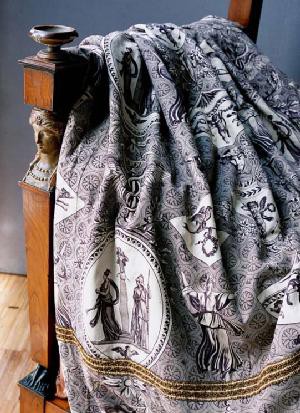The printed cloth manufactory founded by Christophe-Philippe Oberkampf (1738-1815) in Jouy-en-Josas (near to Paris) in 1760, whose most famous products are known as 'toiles de Jouy' (Jouy cloth), was particularly prosperous during the Empire period. Easier to manage than silk, printed cotton was very much in vogue and therefore used as decoration for a whole variety of products, from clothes to interior decoration. The most glorious year for the manufactory was 1806. Oberkampf was awarded a first class gold medal at the Exposition des produits de l'Industrie (Industry and Produce Exhibition) and more importantly on 20 June 1806, he received a visit from the Imperial couple, at the climax of which, Napoleon removed his own Légion d'honneur star to decorate Oberkampf with it, remarking that “no-one was worthier to wear it”. As a souvenir of this scene, Josephine had it painted by Isabey.
Napoleon's interest in the decorative arts should be seen in terms of his general policy of attempting to relaunch the French economy; with respect to the cotton industry, this interest was even greater given his desire to compete with British production. In 1810, some days after a later visit to the manufactory, this time accompanied by Marie-Louise, Napoleon declared to Oberkampf: “you and I, we are fighting a good war with the 'English'; you with your industry and me with my arms. And you are still doing better”. The Jouy manufactory was hit harshly by the effects of the British blockade and Napoleon's Continental System, suffering serious supply problems after 1807.
The Pallas and Venus cloth dates from 1806. The motifs are attributed to Jean-Baptiste Huet (1745-1811), a painter of landscape and pastoral scenes who participated in the Salons from 1769 to 1802. Huet began working with the Jouy, Gobelins and Beauvais manufactories in 1790 and became a faithful collaborator, providing Oberkampf with many designs for the Jouy cloth, including notably an ensemble of scenes taken from antiquity. In this case, exceptionally the cloth is preserved with the bed it was originally designed to cover – the bed is made of rosewood with two rounded heads, with square-section supports decorated with female figures surmounted by antique vases. The cloth, printed using a copper roller and violet ink, shows a typically Neo-classical design: mythological scenes, women in the antique manner, caduceuses, garlands of grapes, arrows and crowns, etc.
Karine Huguenaud (tr. P.H.)
January 2004
The Jouy Cloth – bed cover: "Pallas and Venus"

- Date :
- circa 1806
- Technique :
- cotton printed using a copper roller - violet ink
- Place held :
- Jouy-en-Josas, the Musée de la Toile de Jouy
- Photo credit :
- ©Musée de la Toile de Jouy - Marc Walter

